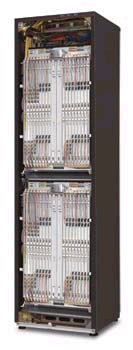Lucent's LambdaUnite Busts Out
Lucent leads debut of LambdaUnite switch with news of Deutsche Telekom adoption -- and a few new details
January 29, 2002

Lucent Technologies Inc. (NYSE: LU) today officially rolled out its high-end optical transport system, the LambdaUnite MultiService Switch (MSS), a box meant to aggregate and forward traffic across metro networks and on to the optical core. The news of the pending announcement was first reported last week in Light Reading (see Lucent Lights Up LambdaUnite), but the official release still held some surprises.
First off, it looks like Lucent's gotten wise to the need to demonstrate customer acceptance of its new products. The company headed off this morning's announcement with news that Deutsche Telekom AG (NYSE: DT), Germany's leading telecom supplier, has signed up to trial the LambdaUnite (see Germans Buy Lucent's LambdaUnite).
And that doesn't mean the PTT is tinkering with it in the lab. "Deutsche Telekom is certifying the LambdaUnite for field deployment. They plan to use it in their broadband transport network nationwide and in some global deployments," says Klaus Dechet, director of product management for LambdaUnite.
He says other customers worldwide also are trialing the box, but he can't divulge their identities yet.
Another surprise: The LambdaUnite is not based on the LambdaRouter or WaveStar Bandwidth Manager, as was supposed in some quarters (Light Reading included). Instead, the box, which combines the functions of a Sonet add/drop multiplexer and crossconnect, features its own ASICs (application-specific integrated circuits) in a new design.
"We have some common interfaces that appear on the Bandwidth Manager, but there are no electrical interfaces in the LambdaUnite. It's a completely new architecture, designed to really make use of the density of the system," Dechet maintains.
LambdaUnite is actually shipping -- yet another surprise, given the track record for big announcements these days. Still, it doesn't have all the features Lucent touted in its initial announcement this fall (see Lucent Unveils Product Lineup). The currently available box is an optical switch with an electrical core that packs 320 Gbit/s of capacity in a non-blocking matrix. It takes up a half-bay in a carrier's central office. It comes with gigabit Ethernet and 2.5- and 10-Gbit/s Sonet (Synchronous Optical NETwork) and SDH (Synchronous Digital Hierarchy) interfaces.
In three months, Lucent says it's going to add 40-Gbit/s, 155-Mbit/s, 622-Mbit/s, and 10-Gbit/s Ethernet connectivity. Prospective buyers will have to wait until the start of 2003, however, to get the full 1.28 Tbit/s capacity (two 320-Gbit/s units in a full bay) originally declared for the LambdaUnite.  Some of the most intriguing revelations about the new box, though, have to do with how Lucent's positioning it against the CoreDirector switch from Ciena Corp. (Nasdaq: CIEN), the market leader in this space.
Some of the most intriguing revelations about the new box, though, have to do with how Lucent's positioning it against the CoreDirector switch from Ciena Corp. (Nasdaq: CIEN), the market leader in this space.
On the face of it, Lucent has clearly attempted to match the CoreDirector's capabilities, albeit falling short in a couple of key areas.
Where CoreDirector offers full bay, 640-Gbit/s capacity today, LambdaUnite only has 320 Gbit/s in a half bay. CoreDirector grooms Sonet traffic to STS1 (51.8Mbit/s) increments, and it grooms SDH traffic to AU3, the European equivalent of STS1. LambdaUnite grooms Sonet STS1s, but in SDH networks the smallest increment groomed is VC4, a slightly less granular connection. CoreDirector features both ring and mesh restoral; LambdaUnite offers only ring.
But Lucent's done its homework overseas. Although it supports VC4 grooming, Dechet says that's sufficient to meet European demand today. "The North American market is different," he asserts. "VC4 is the push in Europe."
Dechet also claims to have a jump on ring restoral in SDH networks. Ciena admits it doesn't yet offer software that supports SNCP (Subnetwork Connnection Protection), a method of ring restoral used in SDH in Europe. Ciena says CoreDirector has the hardware in place to support SNCP, but the software will ship this spring. LambdaUnite offers this now.
LambdaUnite also features gigabit Ethernet interfaces today, whereas CoreDirector does not.
Clearly, Lucent's making a play to compete hardest against Ciena in Europe and other locations where SDH rules the metro core. And that may not be a bad approach, given widespread industry skepticism that Lucent can displace Ciena domestically.
In any event, analysts say, Lucent's got a hard row to hoe. "Lucent has a challenge ahead, as they're entering the market a bit late," says David Dunphy, senior analyst at Current Analysis. "Lucent has a great deal of catchup to play in addressing this segment. Support for meshed architectures is not available in this release, and Lucent still has a ways to go to put together its full ION solution. Ciena and Sycamore Networks Inc. [Nasdaq: SCMR] seem to bepicking up traction with a different approach, and recently with more tier-one [carriers]."
— Mary Jander, Senior Editor, Light Reading
http://www.lightreading.com
You May Also Like


.jpg?width=300&auto=webp&quality=80&disable=upscale)







